Sara Beery
Consensus-Driven Active Model Selection
Jul 31, 2025Abstract:The widespread availability of off-the-shelf machine learning models poses a challenge: which model, of the many available candidates, should be chosen for a given data analysis task? This question of model selection is traditionally answered by collecting and annotating a validation dataset -- a costly and time-intensive process. We propose a method for active model selection, using predictions from candidate models to prioritize the labeling of test data points that efficiently differentiate the best candidate. Our method, CODA, performs consensus-driven active model selection by modeling relationships between classifiers, categories, and data points within a probabilistic framework. The framework uses the consensus and disagreement between models in the candidate pool to guide the label acquisition process, and Bayesian inference to update beliefs about which model is best as more information is collected. We validate our approach by curating a collection of 26 benchmark tasks capturing a range of model selection scenarios. CODA outperforms existing methods for active model selection significantly, reducing the annotation effort required to discover the best model by upwards of 70% compared to the previous state-of-the-art. Code and data are available at https://github.com/justinkay/coda.
DataS^3: Dataset Subset Selection for Specialization
Apr 22, 2025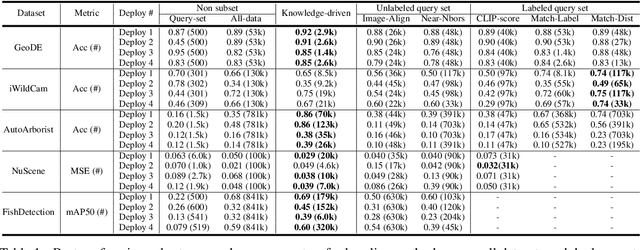

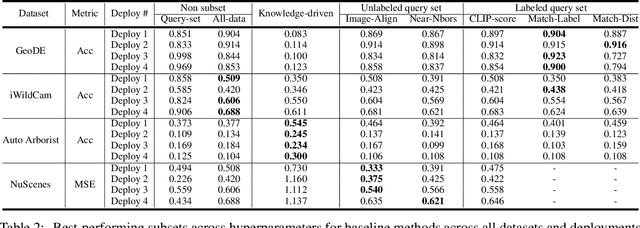
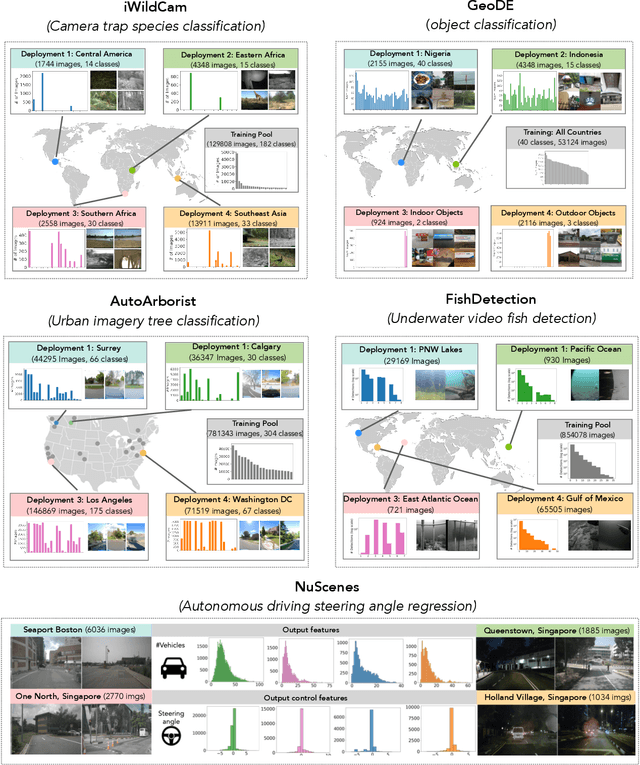
Abstract:In many real-world machine learning (ML) applications (e.g. detecting broken bones in x-ray images, detecting species in camera traps), in practice models need to perform well on specific deployments (e.g. a specific hospital, a specific national park) rather than the domain broadly. However, deployments often have imbalanced, unique data distributions. Discrepancy between the training distribution and the deployment distribution can lead to suboptimal performance, highlighting the need to select deployment-specialized subsets from the available training data. We formalize dataset subset selection for specialization (DS3): given a training set drawn from a general distribution and a (potentially unlabeled) query set drawn from the desired deployment-specific distribution, the goal is to select a subset of the training data that optimizes deployment performance. We introduce DataS^3; the first dataset and benchmark designed specifically for the DS3 problem. DataS^3 encompasses diverse real-world application domains, each with a set of distinct deployments to specialize in. We conduct a comprehensive study evaluating algorithms from various families--including coresets, data filtering, and data curation--on DataS^3, and find that general-distribution methods consistently fail on deployment-specific tasks. Additionally, we demonstrate the existence of manually curated (deployment-specific) expert subsets that outperform training on all available data with accuracy gains up to 51.3 percent. Our benchmark highlights the critical role of tailored dataset curation in enhancing performance and training efficiency on deployment-specific distributions, which we posit will only become more important as global, public datasets become available across domains and ML models are deployed in the real world.
Pairwise Matching of Intermediate Representations for Fine-grained Explainability
Mar 28, 2025



Abstract:The differences between images belonging to fine-grained categories are often subtle and highly localized, and existing explainability techniques for deep learning models are often too diffuse to provide useful and interpretable explanations. We propose a new explainability method (PAIR-X) that leverages both intermediate model activations and backpropagated relevance scores to generate fine-grained, highly-localized pairwise visual explanations. We use animal and building re-identification (re-ID) as a primary case study of our method, and we demonstrate qualitatively improved results over a diverse set of explainability baselines on 35 public re-ID datasets. In interviews, animal re-ID experts were in unanimous agreement that PAIR-X was an improvement over existing baselines for deep model explainability, and suggested that its visualizations would be directly applicable to their work. We also propose a novel quantitative evaluation metric for our method, and demonstrate that PAIR-X visualizations appear more plausible for correct image matches than incorrect ones even when the model similarity score for the pairs is the same. By improving interpretability, PAIR-X enables humans to better distinguish correct and incorrect matches. Our code is available at: https://github.com/pairx-explains/pairx
Open-Set Recognition of Novel Species in Biodiversity Monitoring
Mar 03, 2025Abstract:Machine learning is increasingly being applied to facilitate long-term, large-scale biodiversity monitoring. With most species on Earth still undiscovered or poorly documented, species-recognition models are expected to encounter new species during deployment. We introduce Open-Insects, a fine-grained image recognition benchmark dataset for open-set recognition and out-of-distribution detection in biodiversity monitoring. Open-Insects makes it possible to evaluate algorithms for new species detection on several geographical open-set splits with varying difficulty. Furthermore, we present a test set recently collected in the wild with 59 species that are likely new to science. We evaluate a variety of open-set recognition algorithms, including post-hoc methods, training-time regularization, and training with auxiliary data, finding that the simple post-hoc approach of utilizing softmax scores remains a strong baseline. We also demonstrate how to leverage auxiliary data to improve the detection performance when the training dataset is limited. Our results provide timely insights to guide the development of computer vision methods for biodiversity monitoring and species discovery.
Counting Fish with Temporal Representations of Sonar Video
Feb 07, 2025



Abstract:Accurate estimates of salmon escapement - the number of fish migrating upstream to spawn - are key data for conservation and fishery management. Existing methods for salmon counting using high-resolution imaging sonar hardware are non-invasive and compatible with computer vision processing. Prior work in this area has utilized object detection and tracking based methods for automated salmon counting. However, these techniques remain inaccessible to many sonar deployment sites due to limited compute and connectivity in the field. We propose an alternative lightweight computer vision method for fish counting based on analyzing echograms - temporal representations that compress several hundred frames of imaging sonar video into a single image. We predict upstream and downstream counts within 200-frame time windows directly from echograms using a ResNet-18 model, and propose a set of domain-specific image augmentations and a weakly-supervised training protocol to further improve results. We achieve a count error of 23% on representative data from the Kenai River in Alaska, demonstrating the feasibility of our approach.
Do Large Language Model Benchmarks Test Reliability?
Feb 05, 2025Abstract:When deploying large language models (LLMs), it is important to ensure that these models are not only capable, but also reliable. Many benchmarks have been created to track LLMs' growing capabilities, however there has been no similar focus on measuring their reliability. To understand the potential ramifications of this gap, we investigate how well current benchmarks quantify model reliability. We find that pervasive label errors can compromise these evaluations, obscuring lingering model failures and hiding unreliable behavior. Motivated by this gap in the evaluation of reliability, we then propose the concept of so-called platinum benchmarks, i.e., benchmarks carefully curated to minimize label errors and ambiguity. As a first attempt at constructing such benchmarks, we revise examples from fifteen existing popular benchmarks. We evaluate a wide range of models on these platinum benchmarks and find that, indeed, frontier LLMs still exhibit failures on simple tasks such as elementary-level math word problems. Analyzing these failures further reveals previously unidentified patterns of problems on which frontier models consistently struggle. We provide code at https://github.com/MadryLab/platinum-benchmarks
Personalized Representation from Personalized Generation
Dec 20, 2024Abstract:Modern vision models excel at general purpose downstream tasks. It is unclear, however, how they may be used for personalized vision tasks, which are both fine-grained and data-scarce. Recent works have successfully applied synthetic data to general-purpose representation learning, while advances in T2I diffusion models have enabled the generation of personalized images from just a few real examples. Here, we explore a potential connection between these ideas, and formalize the challenge of using personalized synthetic data to learn personalized representations, which encode knowledge about an object of interest and may be flexibly applied to any downstream task relating to the target object. We introduce an evaluation suite for this challenge, including reformulations of two existing datasets and a novel dataset explicitly constructed for this purpose, and propose a contrastive learning approach that makes creative use of image generators. We show that our method improves personalized representation learning for diverse downstream tasks, from recognition to segmentation, and analyze characteristics of image generation approaches that are key to this gain.
Adapting the re-ID challenge for static sensors
Nov 30, 2024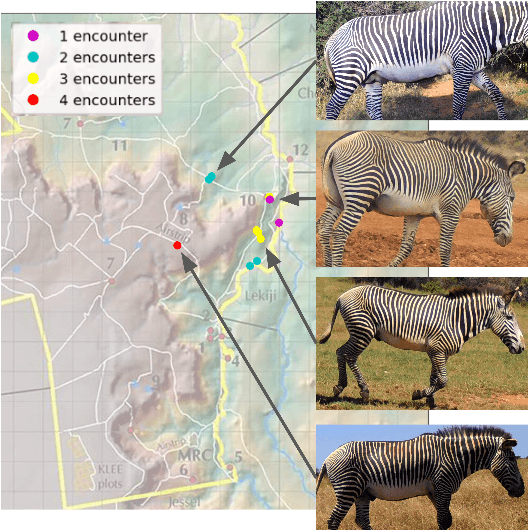

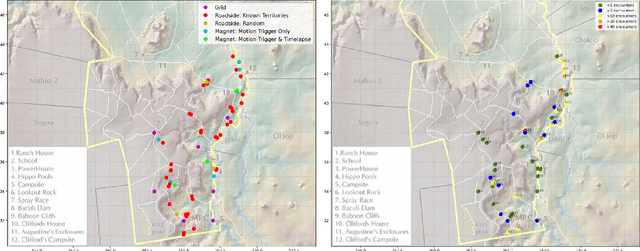

Abstract:In both 2016 and 2018, a census of the highly-endangered Grevy's zebra population was enabled by the Great Grevy's Rally (GGR), a citizen science event that produces population estimates via expert and algorithmic curation of volunteer-captured images. A complementary, scalable, and long-term Grevy's population monitoring approach involves deploying camera trap networks. However, in both scenarios, a substantial majority of zebra images are not usable for individual identification due to poor in-the-wild imaging conditions; camera trap images in particular present high rates of occlusion and high spatio-temporal similarity within image bursts. Our proposed filtering pipeline incorporates animal detection, species identification, viewpoint estimation, quality evaluation, and temporal subsampling to obtain individual crops suitable for re-ID, which are subsequently curated by the LCA decision management algorithm. Our method processed images taken during GGR-16 and GGR-18 in Meru County, Kenya, into 4,142 highly-comparable annotations, requiring only 120 contrastive human decisions to produce a population estimate within 4.6% of the ground-truth count. Our method also efficiently processed 8.9M unlabeled camera trap images from 70 cameras at the Mpala Research Centre in Laikipia County, Kenya over two years into 685 encounters of 173 individuals, requiring only 331 contrastive human decisions.
INQUIRE: A Natural World Text-to-Image Retrieval Benchmark
Nov 04, 2024Abstract:We introduce INQUIRE, a text-to-image retrieval benchmark designed to challenge multimodal vision-language models on expert-level queries. INQUIRE includes iNaturalist 2024 (iNat24), a new dataset of five million natural world images, along with 250 expert-level retrieval queries. These queries are paired with all relevant images comprehensively labeled within iNat24, comprising 33,000 total matches. Queries span categories such as species identification, context, behavior, and appearance, emphasizing tasks that require nuanced image understanding and domain expertise. Our benchmark evaluates two core retrieval tasks: (1) INQUIRE-Fullrank, a full dataset ranking task, and (2) INQUIRE-Rerank, a reranking task for refining top-100 retrievals. Detailed evaluation of a range of recent multimodal models demonstrates that INQUIRE poses a significant challenge, with the best models failing to achieve an mAP@50 above 50%. In addition, we show that reranking with more powerful multimodal models can enhance retrieval performance, yet there remains a significant margin for improvement. By focusing on scientifically-motivated ecological challenges, INQUIRE aims to bridge the gap between AI capabilities and the needs of real-world scientific inquiry, encouraging the development of retrieval systems that can assist with accelerating ecological and biodiversity research. Our dataset and code are available at https://inquire-benchmark.github.io
Tree-D Fusion: Simulation-Ready Tree Dataset from Single Images with Diffusion Priors
Jul 14, 2024Abstract:We introduce Tree D-fusion, featuring the first collection of 600,000 environmentally aware, 3D simulation-ready tree models generated through Diffusion priors. Each reconstructed 3D tree model corresponds to an image from Google's Auto Arborist Dataset, comprising street view images and associated genus labels of trees across North America. Our method distills the scores of two tree-adapted diffusion models by utilizing text prompts to specify a tree genus, thus facilitating shape reconstruction. This process involves reconstructing a 3D tree envelope filled with point markers, which are subsequently utilized to estimate the tree's branching structure using the space colonization algorithm conditioned on a specified genus.
 Add to Chrome
Add to Chrome Add to Firefox
Add to Firefox Add to Edge
Add to Edge